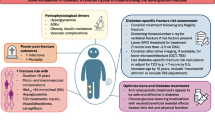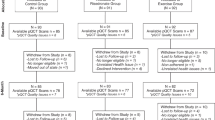Abstract
Using data from the Peking Vertebral Fracture Study, we conducted a longitudinal cohort study to investigate the association between type 2 diabetes mellitus (T2DM) and the risk of incident fractures, especially of vertebral fractures (VFs), and we also examined the modifying effect of body mass index (BMI) on this association and the effect of bone mineral density (BMD) T-score as a risk factor for incident fractures in T2DM. Chinese postmenopausal women were enrolled (n = 982), among whom 186 had T2DM. Incident VFs were confirmed by lateral radiographs of the thoracolumbar spine (T4–L5), while incident clinical non-VFs were self-reported. BMDs at the lumbar spine (LS) and femoral neck (FN) were measured by dual-energy X-ray absorptiometry. T2DM and non-DM women were at similar risk for VFs (OR 0.74, 95% CI 0.32–1.74), even adjusting for age, BMI, BMD, and previous fractures. Meanwhile, T2DM women had nearly twice the risk for non-VFs (HR 1.95, 95% CI 1.11–3.35) compared with non-DM women. After stratifying by BMI, the risk of VFs remained similar between diabetics and non-diabetics despite their BMI status (p for interaction = 0.470), and the risk of non-VFs was positively associated with T2DM only in women with BMI ≥ 25 kg/m2 (HR 3.59, 95% CI 1.68–7.65) (p for interaction = 0.065). Although LS BMD T-score was similarly and negatively associated with incident VFs both in T2DM (OR 0.34, 95% CI 0.12–0.88) and non-DM women (OR 0.60, 95% CI 0.44–0.82) (p for interaction = 0.430), the FN BMD T-score was not found to be significantly associated with either non-VFs or VFs among T2DM women. Comparing T2DM and non-DM women with similar fracture risks, the mean difference in LS T-score was − 0.36 (95% CI − 1.77 to 1.04) for VF, and difference in FN T-score was 1.61 (95% CI − 0.11 to 3.34) for non-VF. In conclusion, Chinese postmenopausal women with T2DM had a similar risk of incident VFs, but a significantly higher risk of incident non-VF, compared to women without DM. Higher BMI did not modify the effect of T2DM on risk of VFs, but it increased the association between T2DM and risk of non-VFs. LS BMD T-score was similarly and negatively associated with VF risk in T2DM and non-DM women and appear to be useful for clinical evaluation of VF risk.

Similar content being viewed by others
References
Meyer HE, Tverdal A, Falch JA (1993) Risk factors for hip fracture in middle-aged Norwegian women and men. Am J Epidemiol 137(11):1203–1211
Forsén L, Meyer HE, Midthjell K, Edna TH (1999) Diabetes mellitus and the incidence of hip fracture: results from the Nord-Trøndelag Health Survey. Diabetologia 42(8):920–925
Ivers RQ, Cumming RG, Mitchell P, Peduto AJ (2001) Diabetes and risk of fracture: The Blue Mountains Eye Study. Diabetes Care 24(7):1198–1203
Luetters CM, Keegan TH, Sidney S et al (2004) Risk factors for foot fracture among individuals aged 45 years and older. Osteoporos Int 15(12):957–963
Bonds DE, Larson JC, Schwartz AV et al (2006) Risk of fracture in women with type 2 diabetes: the Women’s Health Initiative Observational Study. J Clin Endocrinol Metab 91(9):3404–3410
Jiajue R, Jiang Y, Wang O et al (2014) Suppressed bone turnover was associated with increased osteoporotic fracture risks in non-obese postmenopausal Chinese women with type 2 diabetes mellitus. Osteoporos Int 25(8):1999–2005
Liao CC, Lin CS, Shih CC et al (2014) Increased risk of fracture and postfracture adverse events in patients with diabetes: two nationwide population-based retrospective cohort studies. Diabetes Care 37(8):2246–2252
Koh WP, Wang R, Ang LW, Heng D, Yuan JM, Yu MC (2010) Diabetes and risk of hip fracture in the Singapore Chinese Health Study. Diabetes Care 33(8):1766–1770
Holmberg AH, Johnell O, Nilsson PM, Nilsson J, Berglund G, Akesson K (2006) Risk factors for fragility fracture in middle age. A prospective population-based study of 33,000 men and women. Osteoporos Int 17(7):1065–1077
Janghorbani M, Feskanich D, Willett WC, Hu F (2006) Prospective study of diabetes and risk of hip fracture: the Nurses’ Health Study. Diabetes Care 29(7):1573–1578
Kanazawa I, Yamaguchi T, Yamamoto M, Yamauchi M, Yano S, Sugimoto T (2008) Combination of obesity with hyperglycemia is a risk factor for the presence of vertebral fractures in type 2 diabetic men. Calcif Tissue Int 83(5):324–331
Yamamoto M, Yamaguchi T, Yamauchi M, Kaji H, Sugimoto T (2009) Diabetic patients have an increased risk of vertebral fractures independent of BMD or diabetic complications. J Bone Miner Res 24(4):702–709
Schwartz AV, Sellmeyer DE, Ensrud KE et al (2001) Older women with diabetes have an increased risk of fracture: a prospective study. J Clin Endocrinol Metab 86(1):32–38
Napoli N, Strotmeyer ES, Ensrud KE et al (2014) Fracture risk in diabetic elderly men: the MrOS study. Diabetologia 57(10):2057–2065
Tseng VL, Yu F, Lum F, Coleman AL (2012) Risk of fractures following cataract surgery in Medicare beneficiaries. JAMA 308(5):493–501
Holm JP, Jensen T, Hyldstrup L, Jensen JB (2018) Fracture risk in women with type II diabetes. Results from a historical cohort with fracture follow-up. Endocrine 60(1):151–158
Vestergaard P (2007) Discrepancies in bone mineral density and fracture risk in patients with type 1 and type 2 diabetes–a meta-analysis. Osteoporos Int 18(4):427–444
Ford ES, Giles WH, Dietz WH (2002) Prevalence of the metabolic syndrome among US adults: findings from the third National Health and Nutrition Examination Survey. JAMA 287(3):356–359
Torréns JI, Skurnick J, Davidow AL et al (2004) Ethnic differences in insulin sensitivity and beta-cell function in premenopausal or early perimenopausal women without diabetes: the Study of Women’s Health Across the Nation (SWAN). Diabetes Care 27(2):354–361
Gu D, Reynolds K, Wu X et al (2005) Prevalence of the metabolic syndrome and overweight among adults in China. Lancet 365(9468):1398–1405
Ensrud KE, Blackwell TL, Fink HA et al (2016) What proportion of incident radiographic vertebral fractures in older men is clinically diagnosed and vice versa: a prospective study. J Bone Miner Res 31(8):1500–1503
Cooper C, Atkinson EJ, O’Fallon WM, Melton LJ (1992) Incidence of clinically diagnosed vertebral fractures: a population-based study in Rochester, Minnesota, 1985-1989. J Bone Miner Res 7(2):221–227
Hanley DA, Brown JP, Tenenhouse A et al (2003) Associations among disease conditions, bone mineral density, and prevalent vertebral deformities in men and women 50 years of age and older: cross-sectional results from the Canadian Multicentre Osteoporosis Study. J Bone Miner Res 18(4):784–790
Napoli N, Schwartz AV, Schafer AL, Vittinghoff E, Cawthon PM, Parimi N, Orwoll E, Strotmeyer ES, Hoffman AR, Barrett-Connor E, Black DM (2018) Vertebral fracture risk in diabetic elderly men: the MrOS study. J Bone Miner Res 33:63–69
Yamamoto M, Yamaguchi T, Nawata K, Yamauchi M, Sugimoto T (2012) Decreased PTH levels accompanied by low bone formation are associated with vertebral fractures in postmenopausal women with type 2 diabetes. J Clin Endocrinol Metab 97:1277–1284
Tuominen JT, Impivaara O, Puukka P, Rönnemaa T (1999) Bone mineral density in patients with type 1 and type 2 diabetes. Diabetes Care 22:1196–1200
Sahin G, Bağis S, Cimen OB, Ozişik S, Güler H, Erdoğan C (2001) Lumbar and femoral bone mineral density in type 2 Turkish diabetic patients. Acta Medica (Hradec Kralove) 44:141–143
Compston J (2018) Type 2 diabetes mellitus and bone. J Intern Med 283:140–153
Ferrari SL, Abrahamsen BD, Napoli N et al (2018) Diagnosis and management of bone fragility in diabetes: an emerging challenge. Osteoporos Int 29(12):2585–2596
Napoli N, Chandran M, Pierroz DD, Abrahamsen B, Schwartz AV, Ferrari SL (2017) Mechanisms of diabetes mellitus-induced bone fragility. Nat Rev Endocrinol 13(4):208–219
Starup-Linde J, Eriksen SA, Lykkeboe S, Handberg A, Vestergaard P (2014) Biochemical markers of bone turnover in diabetes patients—a meta-analysis, and a methodological study on the effects of glucose on bone markers. Osteoporos Int 25:1697–1708
Starup-Linde J, Vestergaard P (2016) Biochemical bone turnover markers in diabetes mellitus—a systematic review. Bone 82:69–78
Yamamoto M, Yamauchi M, Sugimoto T (2013) Elevated sclerostin levels are associated with vertebral fractures in patients with type 2 diabetes mellitus. J Clin Endocrinol Metab 98:4030–4037
De Laet C, Kanis JA, Odén A et al (2005) Body mass index as a predictor of fracture risk: a meta-analysis. Osteoporos Int 16(11):1330–1338
Department of Disease Control Ministry of Health, PR China (2006) Guidelines for prevention and control of overweight and obesity in Chinese adults. People’s Medical Publishing House, Beijing
Zhao J, Xia W, Nie M et al (2011) The levels of bone turnover markers in Chinese postmenopausal women: peking Vertebral Fracture study. Menopause 18(11):1237–1243
Zhao J, Xia W, Nie M et al (2012) A haplotype of MATN3 is associated with vertebral fracture in Chinese postmenopausal women: peking Vertebral Fracture (PK-VF) study. Bone 50(4):917–924
Zhang ZHSJX, Shen JX (2005) Liu ZH (2005) Retrospective study on standardization of BMD machines in China. Chin J Osteoporos 11(2):133–145
Genant HK, Wu CY, van Kuijk C, Nevitt MC (1993) Vertebral fracture assessment using a semiquantitative technique. J Bone Miner Res 8(9):1137–1148
Schwartz AV, Vittinghoff E, Bauer DC, Hillier TA, Strotmeyer ES, Ensrud KE, Donaldson MG, Cauley JA, Harris TB, Koster A, Womack CR, Palermo L, Black DM (2011) Association of BMD and FRAX score with risk of fracture in older adults with type 2 diabetes. JAMA 305:2184–2192
Christiansen BA, Kopperdahl DL, Kiel DP, Keaveny TM, Bouxsein ML (2011) Mechanical contributions of the cortical and trabecular compartments contribute to differences in age-related changes in vertebral body strength in men and women assessed by QCT-based finite element analysis. J Bone Miner Res 26(5):974–983
Burghardt AJ, Issever AS, Schwartz AV et al (2010) High-resolution peripheral quantitative computed tomographic imaging of cortical and trabecular bone microarchitecture in patients with type 2 diabetes mellitus. J Clin Endocrinol Metab 95(11):5045–5055
Oei L, Zillikens MC, Dehghan A et al (2013) High bone mineral density and fracture risk in type 2 diabetes as skeletal complications of inadequate glucose control: the Rotterdam Study. Diabetes Care 36(6):1619–1628
Patsch JM, Burghardt AJ, Yap SP et al (2013) Increased cortical porosity in type 2 diabetic postmenopausal women with fragility fractures. J Bone Miner Res 28(2):313–324
Kurra S, Siris E (2011) Diabetes and bone health: the relationship between diabetes and osteoporosis-associated fractures. Diabetes Metab Res Rev 27(5):430–435
Cundy TF, Edmonds ME, Watkins PJ (1985) Osteopenia and metatarsal fractures in diabetic neuropathy. Diabetes Med 2(6):461–464
Kathol MH, el-Khoury GY, Moore TE, Marsh JL (1991) Calcaneal insufficiency avulsion fractures in patients with diabetes mellitus. Radiology 180(3):725–729
Acknowledgements
Our deepest gratitude to all the study participants and to the participating centers of the original parent study: Department of Endocrinology, China Rehabilitation Research Center; Department of Endocrinology, Beijing Liangxiang Hospital; Department of Cadre Unit, General Hospital of the Second Artillery Force; Department of Endocrinology, Peking University Shougang Hospital; Department of Endocrinology, Beijing Chaoyang Hospital, Capital University of Medical Science; Department of Endocrinology, Beijing Haidian Hospital; Department of Geriatric Endocrinology, Chinese People’s Liberation Army, General Hospital. We would also like to thank Ms. Yingying Hu for her valuable work in testing biomarker. The Peking Vertebral Fracture Study (PK-VF) was funded by the National Natural Science Foundation of China (No.81070687 and 81170805), National Science and Technology Pillar Program (2006BAI02B03), National Science and Technology Major Projects for “Major New Drugs Innovation and Development” (Grant2008ZX09312-016), Beijing Natural Science Foundation (No. 7121012), Scientific Research Foundation of Beijing Medical Development (No. 2007-3029), and National Key Program of Clinical Science (WBYZ2011-873).
Author information
Authors and Affiliations
Corresponding author
Ethics declarations
Conflict of interest
Ruizhi Jiajue, Xuan Qi, Yan Jiang, Qiuping Wang, Wenbo Wang, Yu Pei, Xiran Wang, Wei Huang, Xin Zheng, Zhiwei Ning, Ou Wang, Mei Li, Xiaoping Xing, Wei Yu, Ling Xu, and Weibo Xia declare that they don’t have any conflicts of interest in this work.
Human and Animal Rights and Informed Consent
All of the subjects agreed to participate in this study and signed informed consent forms.
Additional information
Publisher's Note
Springer Nature remains neutral with regard to jurisdictional claims in published maps and institutional affiliations.
Rights and permissions
About this article
Cite this article
Jiajue, R., Qi, X., Jiang, Y. et al. Incident Fracture Risk in Type 2 Diabetic Postmenopausal Women in Mainland China: Peking Vertebral Fracture Study. Calcif Tissue Int 105, 466–475 (2019). https://doi.org/10.1007/s00223-019-00598-x
Received:
Accepted:
Published:
Issue Date:
DOI: https://doi.org/10.1007/s00223-019-00598-x




